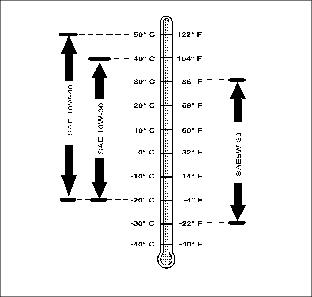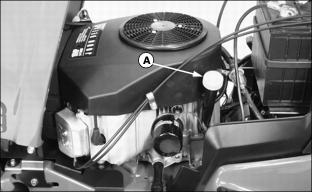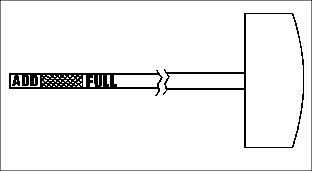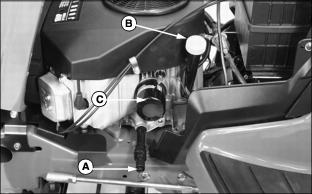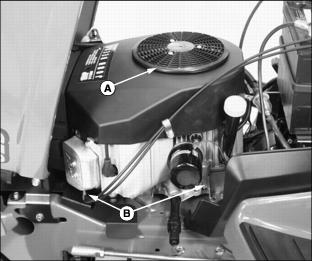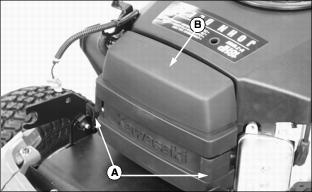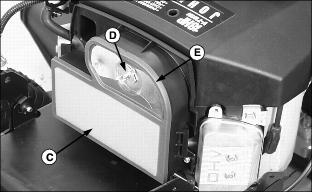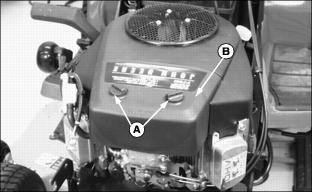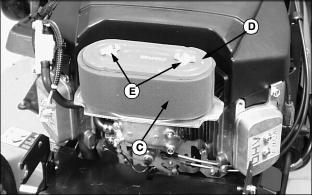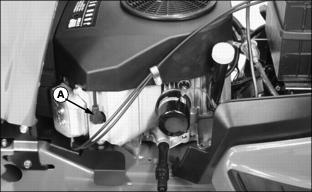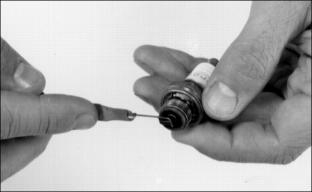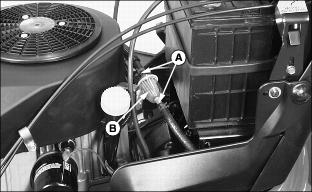Introduction
Product Identification
Safety
Operating
Replacement Parts
Service Intervals
Service Lubrication
Service Engine - Models 325 and 335
Engine Warranty Maintenance Statement
Changing Engine Oil and Filter
Cleaning Air Intake Screen and Engine Fins
Servicing Air Cleaner Elements (Model 325)
Servicing Air Cleaner Elements (Model 335)
Service Engine - Model 345
Service Transmission
Service Steering & Brakes
Service Mower
Service Electrical
Service Miscellaneous
Troubleshooting
Storage
Assembly
Specifications
Warranty
John Deere Quality Statement
Service Record
Copyright© Deere & Company

Service Engine - Models 325 and 335
Engine Warranty Maintenance Statement
Maintenance, repair, or replacement of the emission control devices and systems on this engine, which are being done at the customers expense, may be performed by any non-road engine repair establishment or individual. Warranty repairs must be performed by an authorized John Deere dealer.
Avoid Fumes
Engine Oil (Gas)
Use oil viscosity based on the expected air temperature range during the period between oil changes.
The following John Deere oils are preferred:
Other oils may be used if above John Deere oils are not available, provided they meet the following specification:
· API Service Classification SG or higher
Checking Engine Oil Level
NOTE: Check oil twice a day if you run engine over 4 hours in a day.
Make sure engine is cold when checking engine oil level.
1. Park machine safely. (See Parking Safely in the Safety Section.)
3. Clean area around dipstick to prevent debris from falling into crankcase.
4. Remove dip stick (A). Wipe with clean cloth.
5. Install dipstick into tube, but DO NOT tighten it. Let dipstick threads rest on top of tube.
7. Check oil level on dipstick. Oil must be between ADD and FULL marks.
8. If oil level is low, add oil to bring oil level no higher than FULL mark on dipstick.
9. Install and tighten dipstick. Lower hood.
Changing Engine Oil and Filter
2. Park machine safely on level surface. (See Parking Safely in the Safety Section.)
4. Put drain pan under drain valve. If available, install drain hose.
5. Open drain valve (A) and drain oil into oil drain pan. Allow oil to drain completely.
7. Wipe dirt from around oil filter (C).
8. Place a drain pan or funnel under filter tray.
9. Remove old filter and wipe off filter tray.
10. Put a light coat of fresh, clean oil on the filter gasket.
11. Install replacement oil filter by turning oil filter to the right (clockwise) until the rubber gasket contacts filter base. Tighten filter an additional one-half turn.
14. Install and tighten dipstick.
15. Start and run engine at idle to check for leaks. Stop engine. Fix any leaks before operating.
16. Check oil level, add oil if necessary.
Cleaning Air Intake Screen and Engine Fins
IMPORTANT: Avoid damage! The engine is air-cooled and requires a large amount of air intake when running. Reduced air intake can cause overheating: |
1. Park machine safely. (See Parking Safely in the Safety Section.)
2. Clean air intake screen (A), cooling fins and external surfaces (B), with rag, brush, vacuum or compressed air.
Servicing Air Cleaner Elements (Model 325)
1. Park machine safely. (See Parking Safely in the Safety Section.)
4. Unhook both cover latches (A) to remove cover (B).
NOTE: If precleaner or paper element has a break or is damaged, replace it.
5. If precleaner (C) is dirty, remove it from paper element (E).
6. If paper element is excessively dirty, remove wing nut (D) and element (E). Replace it with a new element.
7. If precleaner is dirty, clean it as follows:
· Wash it in a solution of warm water and liquid detergent. DO NOT wash paper element.
· Squeeze excess water from precleaner.
· Allow precleaner to air dry.
· Add approximately 30 ml (1 oz.) of clean engine oil to precleaner.
· Squeeze precleaner to distribute oil evenly.
8. Install precleaner on paper element.
9. Install air cleaner cover and secure both cover latches.
Servicing Air Cleaner Elements (Model 335)
1. Park machine safely. (See Parking Safely in the Safety Section.)
4. Remove both plastic retainers (A) and cover (B).
5. If precleaner (C) is dirty, remove it from paper element (D).
6. If paper element is excessively dirty, remove wing nuts (E) and element (D). Replace it with a new element.
7. If precleaner is dirty, clean it as follows:
· Wash it in a solution of warm water and liquid detergent. DO NOT wash paper element.
· Squeeze excess water from precleaner.
· Allow precleaner to air dry.
· Add approximately 30 ml (1 oz.) of clean engine oil to precleaner.
· Squeeze precleaner to distribute oil evenly.
8. Install precleaner on paper element.
9. Install air cleaner cover and secure with plastic retainers.
Checking Spark Plug
2. Disconnect spark plug wires (A), one on each side.
4. Clean each spark plug carefully with a wire brush.
· Pitted or damaged electrodes.
NOTE: In Canada, replace spark plug with resistor plug only.
6. Replace spark plugs as necessary.
7. Check plug gap with a wire feeler gauge. To change gap, bend the outer electrode.
8. Install and tighten spark plug. Tighten spark plug to 20 N·m (15 lb-ft).
Adjusting Carburetor
NOTE: Carburetor is calibrated by the engine manufacturer and is not adjustable.
If engine is operated at altitudes above 1829 m (6,000 ft), some carburetors may require a special high altitude main jet. See your John Deere dealer.
If engine is hard to start or runs rough, check the troubleshooting section of this manual.
Possible engine surging will occur at high throttle with transmission in "N" neutral and mower engagement lever disengaged. This is a normal condition due to the emission control system.
After performing the checks in the troubleshooting section and your engine is still not performing correctly, contact your John Deere dealer.
Replacing Fuel Filter
NOTE: Change filter when fuel is low.
1. Park machine safely and lift hood. (See Parking Safely in the Safety Section.)
4. Put a drain pan under fuel filter.
5. Slide two hose clamps (A) away from fuel filter (B) using a pliers.
6. Disconnect hoses from filter.
IMPORTANT: Avoid damage! Incorrect installation of fuel filter may cause engine damage. Install the filter with the arrow pointing in the direction of fuel flow for proper operation. |
7. Connect hoses to new filter making sure the filter arrow is pointed in the direction of the fuel flow.

